Future Skills of Flight Attendants in Times of COVID-19-Related Job Uncertainty—The Case of Germany
Abstract
:1. Introduction
2. Background/Literature
2.1. Work 4.0 and (Future) Competencies
2.2. (Competencies of) Flight Attendants
3. Methodology
3.1. Identification of Key Future Skills from the Literature
3.2. Identification of Job Requirements for Flight Attendants in Germany According to Airline Job Advertisements
- Flight attendant with Lufthansa German Airlines on long and short-haul flights for 16 years, including 12 years as purser;
- Part-time function in an operational support team at Lufthansa headquarters since 2009, acting as an intermediary between flight operations, senior cabin crew management and flight crews to ensure timely and orderly flight operations despite unforeseen challenges in daily operations.
3.3. Survey-Based Determination of the Actual Future Competencies of German-Speaking Flight Attendants
4. Results
4.1. Key Future Skills
4.2. Job Requirements for Flight Attendants in Germany
4.3. Actual Competencies of German-Speaking Flight Attendants (Survey Results)
4.3.1. Socio-Demographics, Secondary Employment and Continuing Education
4.3.2. Importance of Competencies from a Cabin Crew Perspective
4.3.3. Competence Self-Assessment
4.4. Flight Attendants: Future Competence Overlaps and Gaps
5. Discussion
5.1. Key Future Skills
5.1.1. Working with Computers and Programming Computer Systems
5.1.2. Communication, Collaboration and Creativity
5.1.3. Solving Problems
5.1.4. Adapt to Change
5.2. Future Competence Overlaps and Gaps of Flight Attendants
6. Conclusions
6.1. Recommendations
6.2. Limitations
Supplementary Materials
Author Contributions
Funding
Institutional Review Board Statement
Informed Consent Statement
Data Availability Statement
Conflicts of Interest
References
- Agut, Sonia, Rosa Grau, and José María Peiro. 2003. Competency needs among managers from Spanish hotels and restaurants and their training demands. Hospitality Management 22: 281–95. [Google Scholar] [CrossRef]
- Ahlers, Elke, Sandra Mierich, and Aline Zucco. 2021. Homeoffice. Was wir aus der Zeit der Pandemie für die zukünftige Gestaltung von Homeoffice lernen können. WSI Report 65. Available online: https://www.boeckler.de/de/faust-detail.htm?sync_id=HBS-007997 (accessed on 3 December 2021).
- Anger, Christina, Enno Kohlisch, Oliver Koppel, and Axel Plünnecke. 2020. MINT-Herbstreport 2020. MINT-Engpässe und Corona-Pandemie: Kurzfristige Effekte und Langfristige Herausforderungen. Gutachten für BDA, BDI, MINT Zukunft Schaffen und Gesamtmetall. Köln. Available online: https://www.iwkoeln.de/fileadmin/user_upload/Studien/Gutachten/PDF/2020/MINT-Herbstreport_2020.pdf (accessed on 3 December 2021).
- Babbar, Sunil, and Xenophon Koufteros. 2008. The human element in airline service quality: Contact personnel and the customer. International Journal of Operations & Production Management 28: 804–30. [Google Scholar]
- Bani-Salameh, Zakaria A., Muhammad K. Kabilan, and Lina Bani-Salalmeh. 2011. Utilising multimedia ESP programme in enhancing flight attendants’ safety knowledge and problem solving skills. British Journal of Educational Technology 42: 1003–15. [Google Scholar] [CrossRef]
- Batzel, Gisela. 2017. Berufsbildungsbegriffe Deutsch-Englisch. Terminologiesammlung für Berufsbildungsfachleute. Bonn: Bundesinstitut für Berufsbildung. [Google Scholar]
- Bentner, Ariane. 1998. Durch die Welt zu fliegen und ziemlich frei zu sein. Beruf Stewardeß (Aktuelle Frauenforschung). Frankfurt am Main: Ulrike Helmer Verlag. [Google Scholar]
- BMAS—Bundesministerium für Arbeit und Soziales. 2015. Grünbuch Arbeiten 4.0. Arbeiten Weiter Denken; Berlin: Bundesministerium für Arbeit und Soziales. Available online: https://www.bmas.de/SharedDocs/Downloads/DE/Publikationen/gruenbuch-arbeiten-vier-null.pdf;jsessionid=5603D98B878B4F9D8AC29FEC483A7586.delivery1-replication?__blob=publicationFile&v=1 (accessed on 28 September 2021).
- BMAS—Bundesministerium für Arbeit und Soziales. 2017. Kompetenz- und Qualifizierungsbedarfe bis 2030. Ein gemeinsames Lagebild der Partnerschaft für Fachkräfte; Berlin: Bundesministerium für Arbeit und Soziales. Available online: https://www.bmas.de/SharedDocs/Downloads/DE/Publikationen/a758-16-kompetenz-und-qualifizierungsbedarfe.pdf?__blob=publicationFile&v=1 (accessed on 7 December 2021).
- BMBF—Bundesministerium für Bildung und Forschung. 2019. Weiterbildungsverhalten in Deutschland 2018. Ergebnisse des Adult Education Survey—AES-Trendbericht. Available online: https://www.bmbf.de/upload_filestore/pub/Weiterbildungsverhalten_in_Deutschland_2018.pdf (accessed on 27 May 2021).
- Bonin, Holger, Terry Gregory, and Ulrich Zierahn. 2015. Übertragung der Studie von Frey/Osborne (2013) auf Deutschland: Endbericht. Forschungsbericht 455 (Bundesministerium für Arbeit und Soziales & Zentrum für Europäische Wirtschaftsforschung (ZEW) GmbH, Hrsg.). Available online: https://ftp.zew.de/pub/zew-docs/gutachten/Kurzexpertise_BMAS_ZEW2015.pdf (accessed on 29 April 2021).
- Bruckner, Laura, Simon Werther, Moritz Hämmerle, Bastian Pokorni, and Maik Berthold. 2018. Einleitung. In Arbeit 4.0 aktiv gestalten. Die Zukunft der Arbeit zwischen Agilität, People Analytics und Digitalisierung. Edited by Simon Werther and Laura Bruckner. Berlin: Springer, pp. 1–22. [Google Scholar]
- Bruns, Catharina. 2018. Selbstständigkeit in der neuen Arbeitswelt: Entrepreneurship als Praxis für selbstbestimmte Arbeit und eine nachhaltige Wirtschaft. In Arbeitswelt der Zukunft. Trends—Arbeitsraum—Menschen—Kompetenzen. Edited by Harald R. Fortmann and Barbara Kolocek. Wiesbaden: Springer, pp. 264–81. [Google Scholar]
- Bundesagentur für Arbeit. 2018. Flugbegleiterin/Flugbegleiter. Available online: https://www.arbeitsagentur.de/vor-ort/fuerth/download/1533716045164.pdf (accessed on 29 April 2021).
- Bundesinstitut für Berufsbildung. 2015. Definition und Kontextualisierung des Kompetenzbegriffes. Available online: https://www.bibb.de/de/8570.php (accessed on 29 April 2021).
- Cattaneo, Alberto A. P., Chiara Antonietti, and Martina Rauseo. 2022. How digitalised are vocational teachers? Assessing digital competence in vocational education and looking at its underlying factors. Computers & Education 176: 104358. [Google Scholar]
- Chawner, Brenda, and Gillian Oliver. 2013. A survey of New Zealand academic reference librarians: Current and future skills and competencies. Australian Academic & Research Libraries 44: 29–39. [Google Scholar]
- Cheng, Tien-Ming, Shu-Yun Chang, and Yin-Yun Chan. 2018. I know you are suffering from burnout: The moderated mediation effects of “leisure benefits” and “leisure coping” on the burnout model of flight attendants. Journal of Air Transport Management 71: 119–29. [Google Scholar] [CrossRef]
- Choi, Hwansuk Chris, Shuyue Huang, Hyeyoon Choi, and Howook (Sean) Chang. 2020. The effect of flight attendants’ physical attractiveness on satisfaction, positive emotion, perceived value, and behavioral intention. Journal of Hospitality and Tourism Management 44: 19–29. [Google Scholar] [CrossRef]
- Cicek, Kadir, Emre Akyuz, and Metin Celik. 2019. Future Skills Requirements Analysis in Maritime Industry. Procedia Computer Science 158: 270–74. [Google Scholar] [CrossRef]
- Condor. n.d. Flexibler Traumjob über den Wolken. Available online: https://condor-newsroom.condor.com/fileadmin/dam/user_upload/Stellenbeschreibung_-_Flugbegleiter_in_Teilzeit_flexibel_unbefristet__hier_bewerben_.pdf (accessed on 29 April 2021).
- Doerner, Karl, Gabriele Kotsis, and Christine Strauss. 2002. RosterBuilder: An Architecture for an Integrated Airline Rostering Framework. Department of Informatics INF, Copenhagen Business School. Working Paper/Institut for Informatik. Handelshøjskolen i København No. 2002-15. Available online: https://research-api.cbs.dk/ws/portalfiles/portal/58908851/6478.pdf (accessed on 8 December 2021).
- Ehlers, Ulf-Daniel. 2020. Future Skills. Lernen der Zukunft-Hochschule der Zukunft. Wiesbaden: Springer. [Google Scholar] [CrossRef]
- ESCO. 2020a. Get to Know ESCO. Last Update 27/08/2020. Available online: https://ec.europa.eu/esco/portal/home?resetLanguage=true&newLanguage=de (accessed on 28 September 2021).
- ESCO. 2020b. Skills. Last Update 27/08/2020. Available online: https://ec.europa.eu/esco/portal/skill?resetLanguage=true&newLanguage=en&skillFilterIndex=0 (accessed on 28 September 2021).
- European Commission. 2008. The European Qualifications Framework for Lifelong Learning (EQF). Luxembourg: Office for Official Publications of the European Communities, ISBN 978-92-79-08474-4. [Google Scholar] [CrossRef]
- EW Discover. 2021. Cabin Crew Member (m/f/d). Available online: https://www.career.aero/discover/de/job/show/id/3457 (accessed on 21 April 2021).
- Federal Ministry of Labour and Social Affairs of Germany. 2017. Re-Imagining Work: White Paper Work 4.0; Berlin: Federal Ministry of Labour and Social Affairs. Available online: https://www.bmas.de/SharedDocs/Downloads/EN/PDF-Publikationen/a883-white-paper.pdf;jsessionid=CE83F4FFA31514A505653EFD4917166B.delivery1-replication?__blob=publicationFile&v=1 (accessed on 28 September 2021).
- Fidler, Devin. 2016. Future Skills. Update and Literature Review. Institute for the Future. Available online: https://www.iftf.org/fileadmin/user_upload/downloads/wfi/ACTF_IFTF_FutureSkills-report.pdf (accessed on 28 September 2021).
- Fischer, Stephan, André Häusling, Daniel Mühlbauer, Julian Huff, Julian Süß, Christian Vetter, Laura Bruckner, and Simon Werther. 2018. Implikationen von Arbeit 4.0 auf die Personalarbeit. In Arbeit 4.0 aktiv gestalten. Die Zukunft der Arbeit zwischen Agilität, People Analytics und Digitalisierung. Edited by Simon Werther and Laura Bruckner. Berlin: Springer, pp. 87–162. [Google Scholar]
- Ford, Jane, Robert Henderson, and David O’Hare. 2013. Barriers to Intra-Aircraft Communication and Safety: The Perspective of the Flight Attendants. The International Journal of Aviation Psychology 23: 368–87. [Google Scholar] [CrossRef]
- Gatta, Mary, Heather Boushey, and Eileen Appelbaum. 2009. High-Touch and Here-to-Stay: Future Skills Demands in US Low Wage Service Occupations. Sociology 43: 968–89. [Google Scholar] [CrossRef]
- Gibbs, Latoya, Lisa Slevitch, and Isaac Washburn. 2017. Competency-Based Training in Aviation: The Impact on Flight Attendant Performance and Passenger Satisfaction. Journal of Aviation/Aerospace Education & Research 26: 55–80. [Google Scholar]
- Grau-Gumbau, Rosa, Sonia Agut-Nietu, Susana Llorens-Gumbau, and Isabel Maria Martínez-Martínez. 2002. Managerial training needs: A study of Spanish tourism organizations. Tourism and Hospitality Research 3: 234–44. [Google Scholar] [CrossRef]
- Gray, Alex. 2016. The 10 Skills You Need to Thrive in the Fourth Industrial Revolution. Available online: https://www.weforum.org/agenda/2016/01/the-10-skills-you-need-to-thrive-in-the-fourth-industrial-revolution/ (accessed on 28 September 2021).
- Grimm, Reinhard. 2009. Einfach komplex. Neue Herausforderungen im Projektmanagement. Wiesbaden: VS Verlag für Sozialwissenschaften. [Google Scholar]
- Hammermann, Andrea, and Oliver Stettes. 2015. Fachkräftesicherung im Zeichen der Digitalisierung. Empirische Evidenz auf Basis des IW-Personalpanels 2014. Köln: Institut der deutschen Wirtschaft, Available online: https://www.bmwi.de/Redaktion/DE/Downloads/F/fachkraeftesicherung-im-zeichen-der-digitalisierung.pdf?__blob=publicationFile&v=4 (accessed on 28 September 2021).
- Hammermann, Andrea, and Oliver Stettes. 2016. Qualifikationsbedarf und Qualifizierung. Anforderungen im Zeichen der Digitalisierung. IW Policy Paper 3/2016. Available online: https://www.econstor.eu/bitstream/10419/127450/1/847454444.pdf (accessed on 28 September 2021).
- IATA (International Air Transport Association). 2021. Airline Business Confidence Index. October 2021 Survey. November 10. Available online: https://www.iata.org/en/iata-repository/publications/economic-reports/business-confidence-survey---october--2021/ (accessed on 25 November 2021).
- Jacobs, Joh. Christian, E. h. Henning Kagermann, Thomas Sattelberger, Thomas Lange, Philipp Depiereux, Christian van Alphen, Andreas Greve, Till Lohmann, Laura Bruckner, and Simon Werther. 2018. Aktuelle Studien zur Zukunft der Arbeit. In Arbeit 4.0 aktiv gestalten. Die Zukunft der Arbeit zwischen Agilität, People Analytics und Digitalisierung. Edited by Simon Werther and Laura Bruckner. Berlin: Springer, pp. 23–46. [Google Scholar]
- Javed, Muhammad Sabih, Muhammad Razzaq Athar, Abdul Saboor, and Milena Ratajczak-Mrozek. 2019. Development of a twenty-first century skills scale for agri varsities. Cogent Business & Management 6: 1. [Google Scholar] [CrossRef]
- Ji, Ming, Bo Liu, Hongwei Li, Shiyun Yang, and Ying Li. 2019. The effects of safety attitude and safety climate on flight attendants’ proactive personality with regard to safety behaviors. Journal of Air Transport Management 78: 80–86. [Google Scholar] [CrossRef]
- Kao, Li-Hua, Margaret Stewart, and Kai-Hui Lee. 2009. Using structural equation modeling to predict cabin safety outcomes among Taiwanese airlines. Transportation Research Part E: Logistics and Transportation Review 45: 357–65. [Google Scholar] [CrossRef]
- Karatepe, Osman M., and Aram Eslamlou. 2017. Outcomes of job crafting among flight attendants. Journal of Air Transport Management 62: 34–43. [Google Scholar] [CrossRef]
- Karatepe, Osman M., and Sanaz Vatankhah. 2014. The effects of high-performance work practices and job embeddedness on flight attendants’ performance outcomes. Journal of Air Transport Management 37: 27–35. [Google Scholar] [CrossRef]
- Keller, Sarah. 2021. Statistiken zu den Auswirkungen des Coronavirus auf die Luftfahrtindustrie. Statista. Available online: https://de.statista.com/themen/6257/coronavirus-und-luftfahrt/ (accessed on 28 September 2021).
- Kim, Youngmi, and Hyejung Park. 2014. An Investigation of the Competencies Required of Airline Cabin Crew Members: The Case of a Korean Airline. Journal of Human Resources in Hospitality & Tourism 13: 34–62. [Google Scholar]
- Kirchherr, Julian, Julia Klier, Cornels Lehmann-Brauns, and Mathias Winde. 2018. Future Skills. Welche Kompetenzen in Deutschland fehlen. Stifterverband für die Deutsche Wissenschaft (Ed). Available online: https://www.future-skills.net/analysen/future-skills-welche-kompetenzen-in-deutschland-fehlen (accessed on 28 September 2021).
- Kirchherr, Julian, Julia Klier, Volker Meyer-Guckel, and Mathias Winde. 2020. Future Skills Analysen. Die Zukunft der Qualifizierung in Unternehmen nach Corona. Stifterverband für die Deutsche Wissenschaft (Ed.). Available online: https://www.future-skills.net/analysen/die-zukunft-der-qualifizierung-in-unternehmen-nach-corona (accessed on 28 September 2021).
- Koch, Jonas Maximilian. 2017. Kompetenzen des Industriearbeiters 4.0. Fachhochschule Südwestfalen, Hochschulschriften, Standort Meschede 2/2017. Available online: https://www4.fh-swf.de/media/downloads/meschedestandort/hochschulschriften/pdfs_2/02_2017/MHS_2.pdf (accessed on 3 December 2021).
- Kockelke, Kathrin. 2008. Der Einfluss der Bordleistungen auf die Kundenzufriedenheit bei Flugreisen unter besonderer Berücksichtigung des Flugbegleiters. Ph.D. thesis, Universität Mannheim, Mannheim, Germany. Available online: https://madoc.bib.uni-mannheim.de/1949/1/Dissertation_Kockelke.pdf?rs=true&wid= (accessed on 6 December 2021).
- Koenen, Jens. 2020. Sparprogramme bei den Airlines. Wie Andere Fluggesellschaften mit der Krise umgehen. Handelsblatt. September 8. Available online: https://www.handelsblatt.com/unternehmen/handel-konsumgueter/sparprogramme-bei-den-airlines-wie-andere-fluggesellschaften-mit-der-krise-umgehen/26164558.html?ticket=ST-7299064-O0kEwPVPs91e9G1cSG0m-ap3 (accessed on 28 September 2021).
- Kusumo, Laksmi. 2016. Problem-based learning technique in developing the initial flight attendant students’ speaking skills. Proceedings Universitas Pamulang 1: 146–56. [Google Scholar]
- Latson, Jennifer. 2015. Hired for Their Looks, Promoted for Their Heroism: The First Flight Attendants. Time. May 15. Available online: https://time.com/3847732/first-stewardess-ellen-church/ (accessed on 28 September 2021).
- Lee, Chongho, Myungsook An, and Yonghwi Noh. 2012. The Social Dimension of Service Workers’ Job Satisfaction: The Perspective of Flight Attendants. Journal of Service Science and Management 5: 160–70. [Google Scholar] [CrossRef] [Green Version]
- Limprasert, Sirima, and Krit Witthawassamrankul. 2016. English communication problems between passengers and flight attendants: A review. Paper presented at the RTUNC National Conference, Ubon Ratchathani, Thailand, July 29; Available online: https://www.researchgate.net/profile/Krit-Witthawassamrankul/publication/318039199_English_Communication_Problems_between_Passengers_and_Flight_Attendants_A_Review/links/595624d5a6fdcc2569d9b8ab/English-Communication-Problems-between-Passengers-and-Flight-Attendants-A-Review.pdf (accessed on 8 December 2021).
- Lu, Jin-Long, and Feng-I Ling. 2008. Cross-cultural perspectives regarding service quality and satisfaction in Chinese cross-strait airlines. Journal of Air Transport Management 14: 16–19. [Google Scholar] [CrossRef]
- Lufthansa. 2020. Lufthansa Flugbegleiter-Bewerbung: Voraussetzungen (Promotional Video). Available online: https://www.youtube.com/watch?v=OAX46peEmjc (accessed on 6 December 2021).
- Lüneburg, Anke. 2020. Erfolgreich sein als Führungskraft in der Arbeitswelt 4.0. Begeisterung wecken mit Zukunftskompetenzen und Coaching-Tools. Wiesbaden: Springer. [Google Scholar]
- OECD. 2019. OECD Future of education and skills 2030, OECD Learning Compass 2030. Available online: https://www.oecd.org/education/2030-project/contact/OECD_Learning_Compass_2030_Concept_Note_Series.pdf (accessed on 17 September 2020).
- Park, Hyun-Seo, and Hye-Yoon Park. 2019. The Effect of Efficiency Evaluation on the Organizational Effectiveness of the Cabin Crew’s Competency-Focusing on the Job Satisfaction of the Personal Capacity of Airline Cabin Crews. Journal of Distribution Science 17: 5–13. [Google Scholar] [CrossRef]
- Partnership for 21st Century Learning (P21). 2019. Framework for 21st Century Learning Definitions. Available online: https://static.battelleforkids.org/documents/p21/P21_Framework_DefinitionsBFK.pdf (accessed on 18 March 2021).
- Robertson-von Trotha, Caroline Y., Jens Görisch, and Iris Helene Koban. 2009. Projekte zu Schlüsselqualifikationen an Technischen Universitäten. Konzeptionelle Überlegungen, empirische Erhebungen und interuniversitärer Austausch. In Schlüsselqualifikationen für Studium, Beruf und Gesellschaft. Technische Universitäten im Kontext der Kompetenzdiskussion. Edited by Caroline Y. Robertson-von Trotha. Karlsruhe: Universitätsverlag Karlsruhe, pp. 135–68. [Google Scholar]
- Rump, Jutta, and Silke Eilers. 2017. Auf dem Weg zur Arbeit 4.0. Innovationen in HR. Berlin: Springer. [Google Scholar]
- Sauter, Roman, Werner Sauter, and Roland Wolfig. 2018. Agile Werte- und Kompetenzentwicklung. Wege in eine neue Arbeitswelt. Berlin: Springer. [Google Scholar]
- Scheunemann, York. 2018. Selbst. Achtsam. Managen. In Arbeitswelt der Zukunft. Trends-Arbeitsraum-Menschen –Kompetenzen. Edited by Harald R. Fortmann and Barbara Kolocek. Wiesbaden: Springer, pp. 243–81. [Google Scholar]
- Schönfelder, Christoph. 2018. Muße–Garant für unternehmerischen Erfolg. Ihr Potenzial für Führung und die Arbeitswelt 4.0. Wiesbaden: Springer. [Google Scholar]
- Schubert, Sascha. 2018. Grußwort Bundesverband Deutsche Startups e.V. In Arbeit 4.0 aktiv gestalten. Die Zukunft der Arbeit zwischen Agilität, People Analytics und Digitalisierung. Edited by Simon Werther and Laura Bruckner. Berlin: Springer, pp. V–VI. [Google Scholar]
- Seitz, Jelka, and Jürgen Seitz. 2018. Digitale Kompetenzen: New Work = New Human? In Arbeitswelt der Zukunft. Trends-Arbeitsraum-Menschen–Kompetenzen. Edited by Harald R. Fortmann and Barbara Kolocek. Wiesbaden: Springer, pp. 355–82. [Google Scholar]
- Statistisches Bundesamt. 2021. Verkehr. Luftverkehr auf Hauptverkehrsflughäfen. Fachserie 8 Reihe 6.1 2020. Available online: https://www.destatis.de/DE/Themen/Branchen-Unternehmen/Transport-Verkehr/Personenverkehr/Publikationen/Downloads-Luftverkehr/luftverkehr-ausgewaehlte-flugplaetze-2080610207004.pdf;jsessionid=5CE3DC4DAAA49E069F5C80A92F12F4A0.live712?__blob=publicationFile (accessed on 2 June 2021).
- Tang, Au Due, Man-Ling Chang, Tsu-Hui Wang, and Cheng-Hao Lai. 2020. How to create genuine happiness for flight attendants: Effects of internal marketing and work-family interface. Journal of Air Transport Management 87: 101860. [Google Scholar] [CrossRef]
- Tyler, Melissa, and Pamela Abbott. 1998. Chocs Away: Weight Watching in the Contemporary Airline Industry. Sociology 32: 433–50. [Google Scholar] [CrossRef]
- Vatankhah, Sanaz. 2021. Dose safety motivation mediate the effect of psychological contract of safety on flight attendants’ safety performance outcomes?: A social exchange perspective. Journal of Air Transport Management 90: 101945. [Google Scholar] [CrossRef]
- Vieira, Ana Maria, and Isabel Cristina dos Santos. 2010. Communication skills: A mandatory competence for ground and airplane crew to reduce tension in extreme situations. Journal of Aerospace Technology and Management 2: 361–70. [Google Scholar] [CrossRef]
- Wen, Xin, Xuting Sun, Yige Sun, and Xiaohang Yue. 2021. Airline crew scheduling: Models and algorithms. Transportation Research Part E: Logistics and Transportation Review 149: 102304. [Google Scholar] [CrossRef]
- World Economic Forum. 2020. The Future of Jobs Report 2020. Cologny/Geneva. Available online: http://www3.weforum.org/docs/WEF_Future_of_Jobs_2020.pdf (accessed on 1 March 2021).

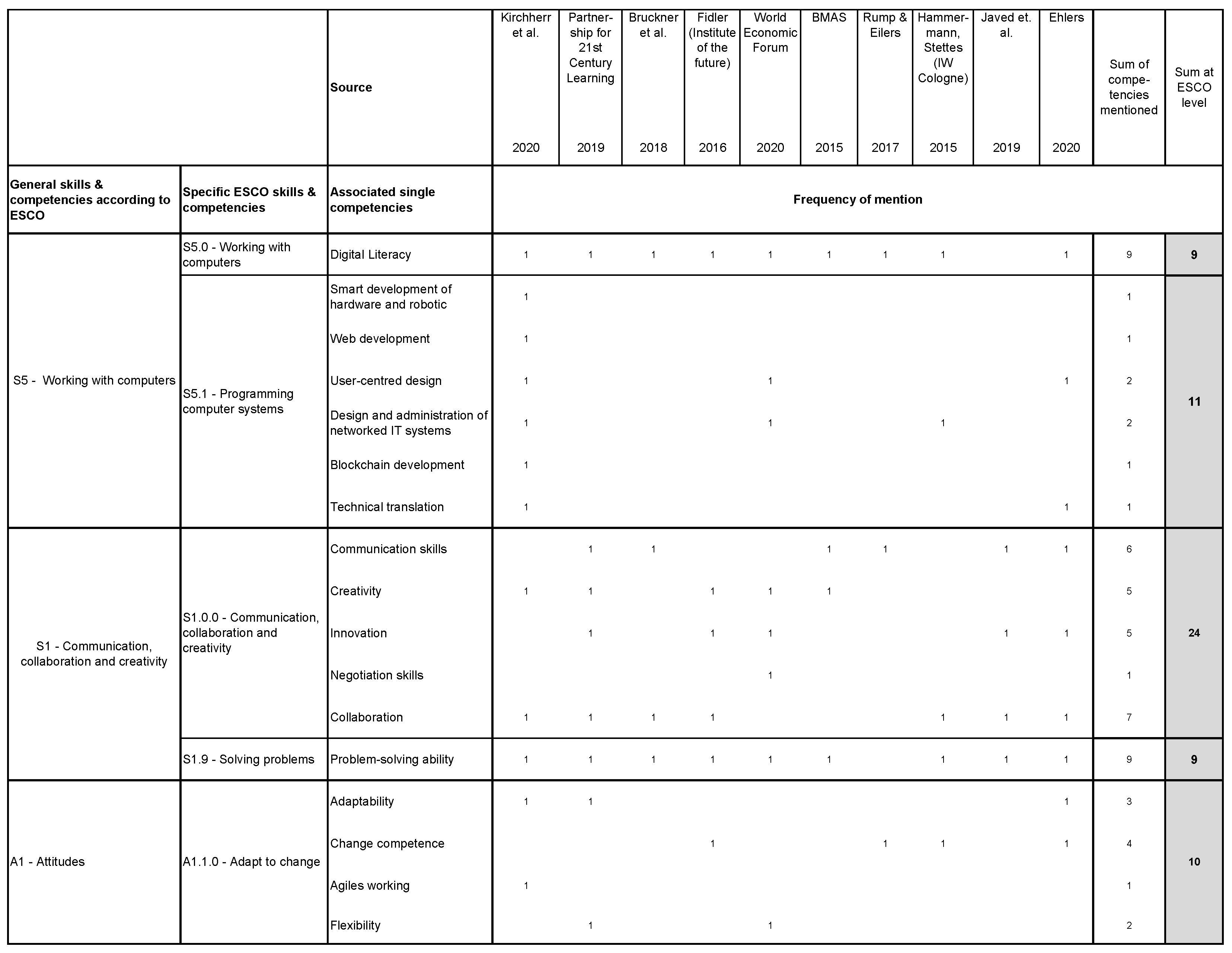

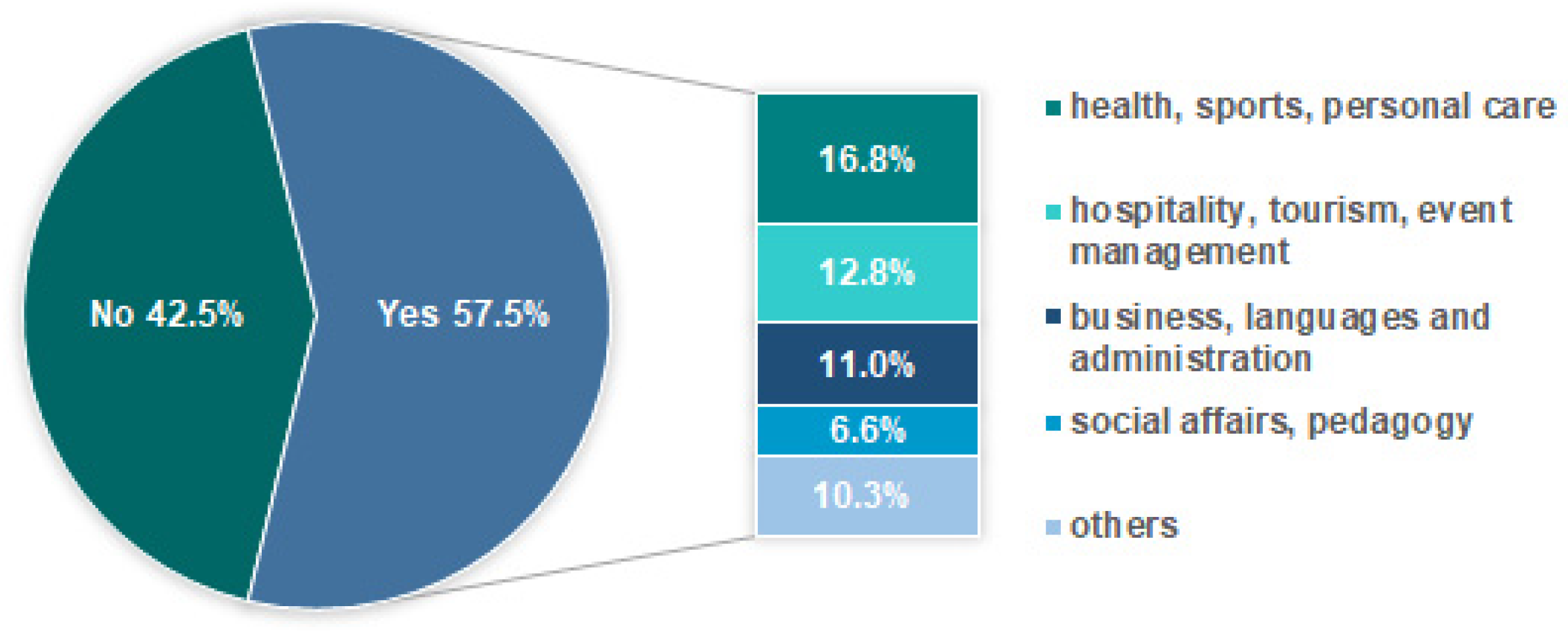
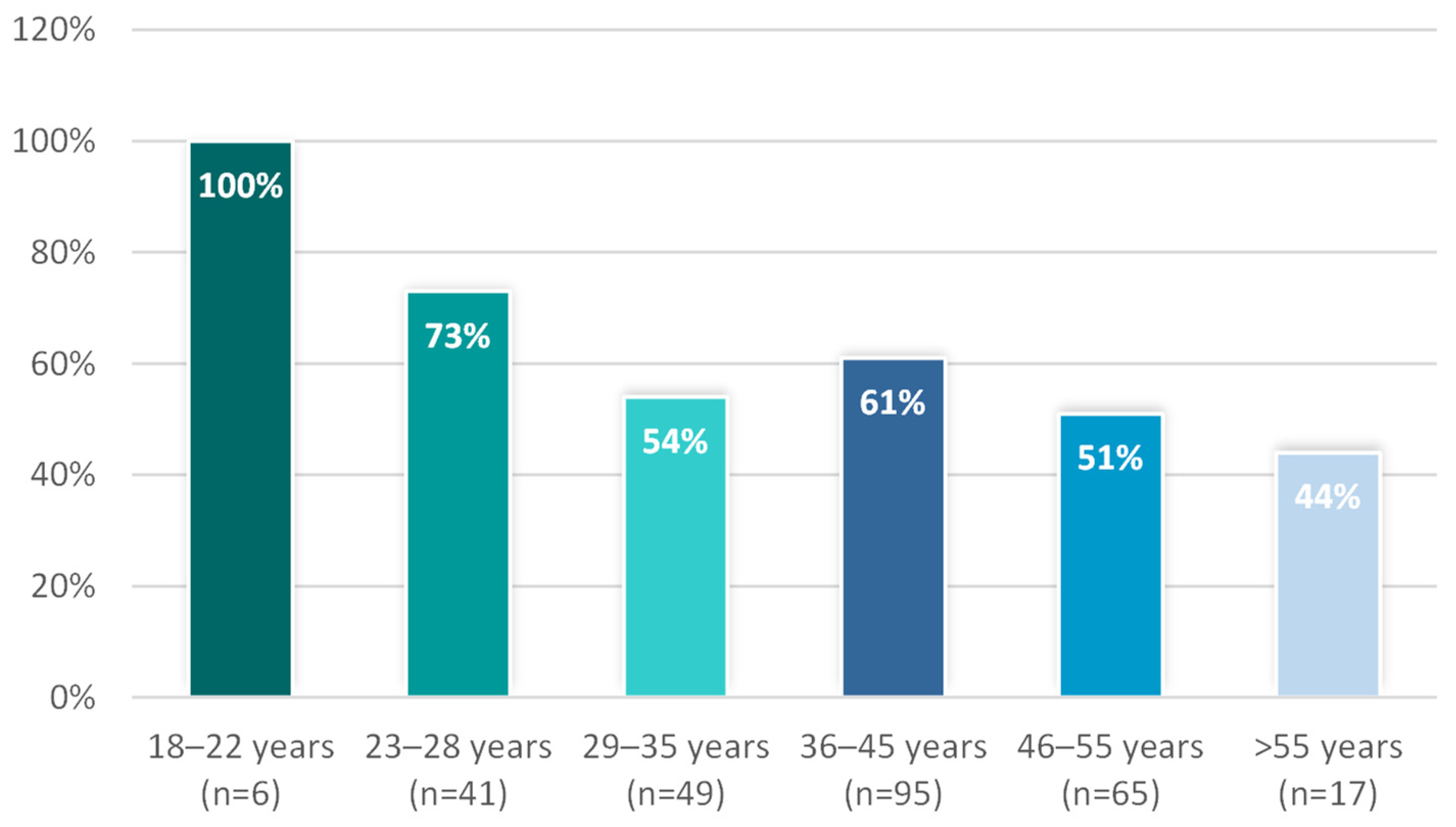
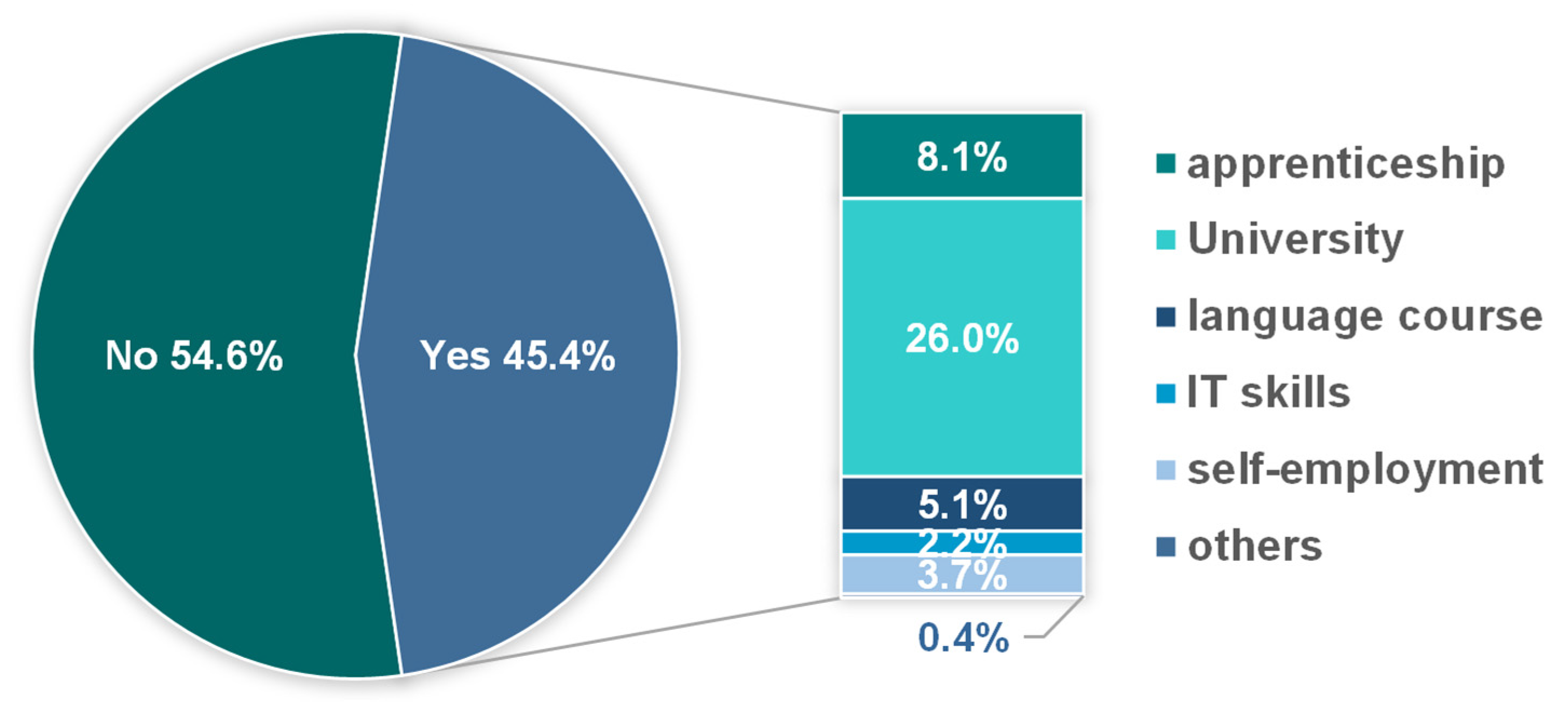
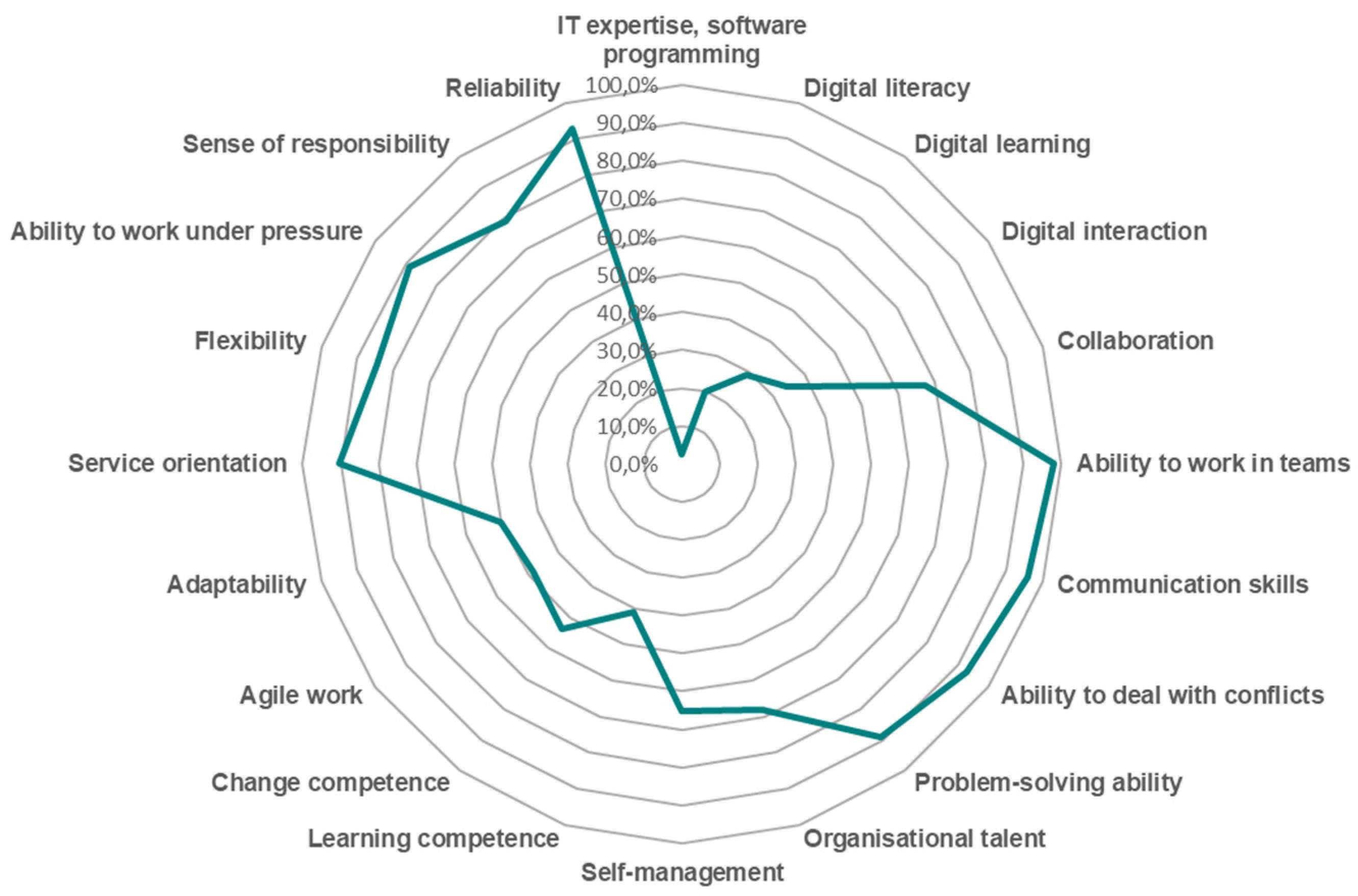

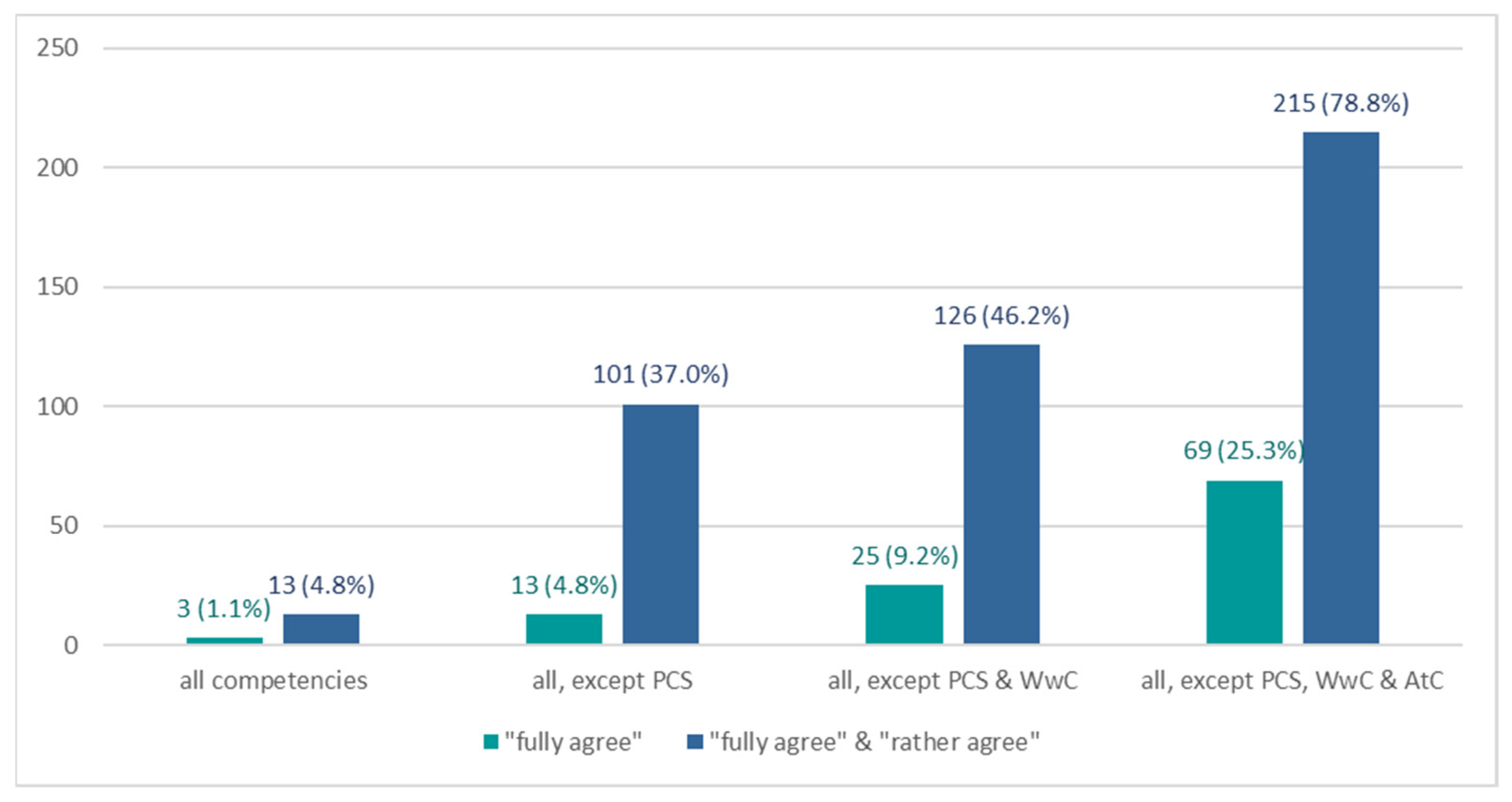
| Issue/Focus | Exemplary Papers |
|---|---|
| Role and (perceived) image of flight attendants | Bentner (1998), Tyler and Abbott (1998), Latson (2015) |
| Cabin crew scheduling and rostering | Doerner et al. (2002), Wen et al. (2021) |
| Impact of cabin crew behavior and performance on safety and customer service (quality) | Babbar and Koufteros (2008), Kockelke (2008), Bani-Salameh et al. (2011), Kao et al. (2009), Vieira and dos Santos (2010), Ford et al. (2013), Karatepe and Vatankhah (2014), Gibbs et al. (2017), Karatepe and Eslamlou (2017), Ji et al. (2019), Choi et al. (2020), Vatankhah (2021) |
| Job satisfaction and mental health | Cheng et al. (2018), Tang et al. (2020), Lee et al. (2012), Park and Park (2019) |
| Flight attendant’s competencies | Lu and Ling (2008), Vieira and dos Santos (2010), Limprasert and Witthawassamrankul (2016), Gibbs et al. (2017), Kusumo (2016) |
| Sex | Age (Years) | Highest Level of Education | # Languages (min B1) |
|---|---|---|---|
| Female 80% Male 19% Diverse 1% | 18–22 2% | Intermediate school-leaving certificate (“Realschule”) 5% A-levels or Vocational baccalaureate 35% Apprenticeship 25% University (of Applied Science) 35% | 2 47% |
| 23–28 15% | 3 22% | ||
| 29–35 18% | 4 7% | ||
| 36–45 35% | 5 3% | ||
| 46–55 24% | 6 3% | ||
| >55 6% | >6 18% |
| Specific ESCO Skills & Competencies | Associated Single Competencies | [A] Essential future Competency According to Literature Review | [B] Airline Requirement Profile for Flight Attendants | [C] Flight Attendant Self-Assessment of Required Competencies | [D] Flight Attendant Self-Assessment of Own (Future) Competencies |
|---|---|---|---|---|---|
| S5.1—Programming computer systems | IT expertise, software programming | x | 3% | 2% | |
| S5.0—Working with computers | Digital Literacy | x | 20% | 22% | |
| S1.0.0—Communication, collaboration and creativity | Collaboration | x | 67% | 62% | |
| Communication skills | x | x | 96% | 49% | |
| Sociability | x | - | - | ||
| S1.9—Solving problems | Problem-solving ability | x | 89% | 45% | |
| S1.8.1—Working in teams | Ability to work in a team | x | 98% | 68% | |
| S1.15.1—Using foreign languages | Multilingualism | x | 100% | 100% | |
| S3.4.4—Providing general assistance to people | High service orientation | x | 90% | 47% | |
| A1.4.0—Cope with pressure | Willingness to work under stress, ability to work under pressure (e.g., irregular working hours) | x | 89% | - | |
| A1.13.0—Meet commitments | Reliability | x | 93% | - | |
| Sense of responsibility | x | 79% | - | ||
| A1.1.0—Adapt to change | Change competence | x | 30% | ||
| Agile working | x | 37% | |||
| Adaptability | x | 29% |
Publisher’s Note: MDPI stays neutral with regard to jurisdictional claims in published maps and institutional affiliations. |
© 2021 by the authors. Licensee MDPI, Basel, Switzerland. This article is an open access article distributed under the terms and conditions of the Creative Commons Attribution (CC BY) license (https://creativecommons.org/licenses/by/4.0/).
Share and Cite
Bremer, K.F.; Maertens, S.U. Future Skills of Flight Attendants in Times of COVID-19-Related Job Uncertainty—The Case of Germany. Adm. Sci. 2021, 11, 154. https://doi.org/10.3390/admsci11040154
Bremer KF, Maertens SU. Future Skills of Flight Attendants in Times of COVID-19-Related Job Uncertainty—The Case of Germany. Administrative Sciences. 2021; 11(4):154. https://doi.org/10.3390/admsci11040154
Chicago/Turabian StyleBremer, Kirsten Friederike, and Sven Ulrich Maertens. 2021. "Future Skills of Flight Attendants in Times of COVID-19-Related Job Uncertainty—The Case of Germany" Administrative Sciences 11, no. 4: 154. https://doi.org/10.3390/admsci11040154
APA StyleBremer, K. F., & Maertens, S. U. (2021). Future Skills of Flight Attendants in Times of COVID-19-Related Job Uncertainty—The Case of Germany. Administrative Sciences, 11(4), 154. https://doi.org/10.3390/admsci11040154





